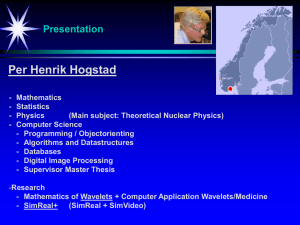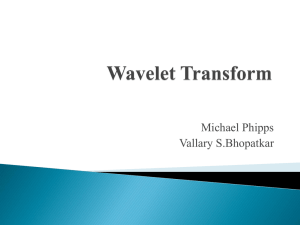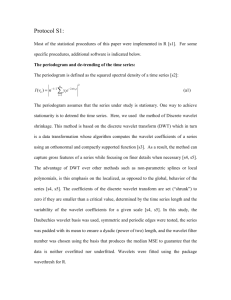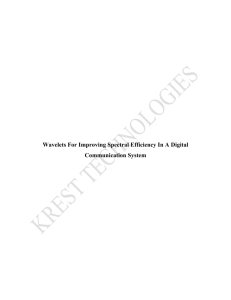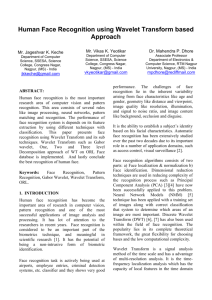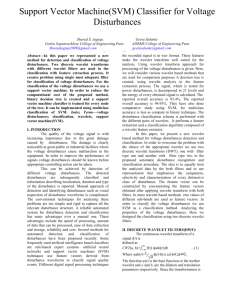SCIENTAL: Scale-based information environment for identification
advertisement
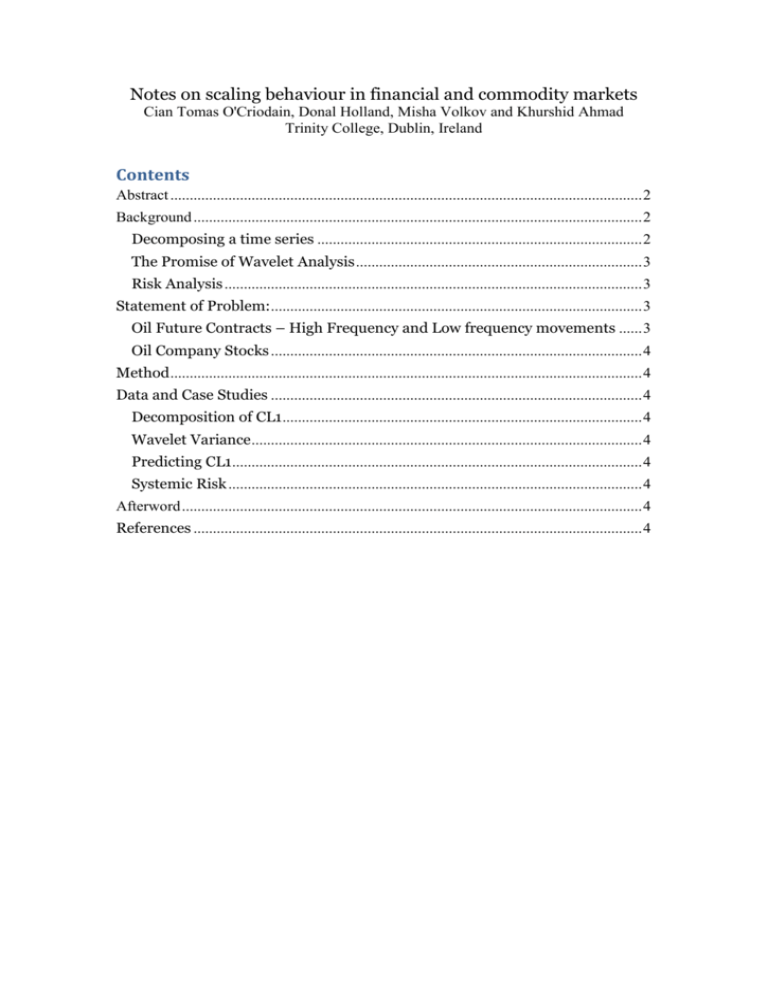
Notes on scaling behaviour in financial and commodity markets Cian Tomas O'Criodain, Donal Holland, Misha Volkov and Khurshid Ahmad Trinity College, Dublin, Ireland Contents Abstract .......................................................................................................................... 2 Background .................................................................................................................... 2 Decomposing a time series .................................................................................... 2 The Promise of Wavelet Analysis .......................................................................... 3 Risk Analysis ............................................................................................................ 3 Statement of Problem: ................................................................................................ 3 Oil Future Contracts – High Frequency and Low frequency movements ...... 3 Oil Company Stocks ................................................................................................ 4 Method .......................................................................................................................... 4 Data and Case Studies ................................................................................................ 4 Decomposition of CL1 ............................................................................................. 4 Wavelet Variance ..................................................................................................... 4 Predicting CL1 .......................................................................................................... 4 Systemic Risk ........................................................................................................... 4 Afterword ....................................................................................................................... 4 References .................................................................................................................... 4 Notes on scaling behaviour in financial and commodity markets Cian Tomas O'Criodain, Donal Holland, Misha Volkov and Khurshid Ahmad Trinity College, Dublin, Ireland Abstract Oil shocks have had a profound effect on a global scale and yet oil prices show a periodicity that is remarkable in itself. Wavelet analysis has been used to decompose an oil futures contract (Cushing Light Oil – CL1) over a 10 year period covering wars, presidential elections, successful peace processes and ambitious economic and social programmes, and major changes in transportation technology. The decomposition is helps in computing wavelet variance at different scales and following Gencay et al.[23] leads to an estimate of systemic risk in oil future prices. We demonstrate a method that can be used to predict price of oil contracts over a limited horizon. Background One of the key properties of complex systems is scale invariance. Consider systems in financial and commodity markets for example: These systems are intrinsically nonlinear, have a multi-scale character in both space and time, and comprise components that show dynamic and interdependent relationships amongst each other: The systems, nevertheless, show a remarkable degree of stability characterised by cyclic change in the values of idiosyncratic variable and by the scale-invariant power law behaviour of control parameters, for instance, trading interval, or the size of an actor – firms large and small. The systemic stability can be ‘shocked’ into linear or non-linear trends for varying periods of time; this may produce volatility clusters, and there maybe longterm effects of the shock observed sometimes by the emergence of variance breaks in financial time series. The shock may be endogenous, caused by the complexity of interaction between constituent parts, or exogenous, caused by external or environmental stimuli. Decomposing a time series Wavelet analysis has ‘formalized old notions of decomposing a series into trend, seasonal and business cycle components’ [38]. The result of the analysis is the reexpression of a highly correlated time series in terms of the combinations of the uncorrelated wavelet coefficients [12][32][36]. These coefficients are associated with oscillations of different periods. In economics and finance the analysis of the raw time series at different scales can be used with some degree of success: (a) to deseasonalise and detrend raw foreign exchange data [21] [39]; (b) to study the scaling behaviour of economic indices [33]; (c) to conduct (Granger-) causality tests of different macroeconomic variables like money supply and real economy variables output [22] which shows no conclusive indication of causality at the raw data level but clear indication of causal connection between the variables at finer scales; (d) to investigate heterogeneous trading in commodity markets and the effect of other financial instrument on the prices [11] (e) to evaluate risk using multiscale beta estimation [23]. Wavelets have been used to test for the onset of trends [24], for stationarity [44], and for predicting the behaviour of financial markets [40] or as a preprocessor of time series for input to fuzzy logic-based prediction system[37]. Note that the wavelet-based approach is similar in spirit to the well-known ARCH and GARCH models [4][5][14][15][43] However, unlike the approach adapted in (G)ARCH models, the wavelet approach breaks down each volatile time series into several time series of very high to very low volatility: these time series can then be studied and interpreted separately. This study appears to the discovery of newer relationships and insights in the analysed data, which are not afforded by the GARCH and ARCH models [39]. The Promise of Wavelet Analysis The potential of multiscale wavelet decompositions in providing new insights in subjects as diverse as hydrology, astronomy, physics and geology, suggests the analysis of economic and financial data will perhaps benefit from wavelet analysis [36]. The roots of the wavelet analysis lie within filtering methods that deal with the identification and extraction of certain features (e.g., trends, seasonalities) from a time series, which are important in terms of modelling and inference. Traditionally, filters in economics and finance are used to extract components of a time series such as trends, business cycles, seasonalities, and noise. Two most commonly used methods of decomposition of a macroeconomic time series are the Beveridge-Nelson procedure [1] and Hodrick-Prescott filter [27]. Canova critically evaluated a set of popular filters used in detrending macroeconomic time series and showed that different detrending methods provide different stylised facts of the U.S. business cycle [7][8]. Burnside claimed that preferring a commonly used filtering method in macroeconomic analysis does not induce any lack of power [6]. Niemira and Klein studied forecasting financial and economic cycles in general [35], and Weigend and Gerschenfeld investigated time series prediction in natural and physical phenomena [45]. Kaiser and Maraval [28], and Diebold and Rudebusch [13] contained a detailed analysis of business cycle measurements and forecasts. Risk Analysis Financial time series do not vary in isolation from one another and their movements are indeed correlated [25]. The capital asset pricing model (CAPM), a tenet of modern financial economics, provides a method to quantify correlations amongst stock prices with a statistic called systematic risk or beta [41][30][29]. The CAPM essentially works on the principle that the expected return of a particular asset is dependent upon the total risk involved in holding that asset: that is, the average return of high beta stocks is higher than the average return of low beta stocks and that this relationship is roughly linear [3][18]. Again, recognizing the effect of time-scale on the beta or risk of an asset, several researchers have studied the stability of beta over different time horizons [26][20][2]. Since, wavelet analysis is a natural tool for studying the timescale properties of time series, its application for the calculation of betas or systematic risks at various time horizons within a CAPM framework are eminent. Gencay et al. provide a comprehensive wavelet-based methodology to calculate systematic risk at various time-scales and show that the relationship between the return of a portfolio and its beta becomes stronger as the time-scale increases [23]. This offers newer research avenues for assessing the risk and value of different cash flows in financial markets. In SCALES, we want to study the risk-return tradeoffs at different timescales and want to investigate their relationship with market sentiment. Statement of Problem: Oil Future Contracts – High Frequency and Low frequency movements Oil Company Stocks Method Data and Case Studies Decomposition of CL1 Wavelet Variance Predicting CL1 Systemic Risk Afterword References [1] [2] [3] [4] [5] [6] [7] [8] [9] [10] [11] [12] Beveridge, S., and C. R. Nelson. 1981. “A new approach to decomposition of economic time series into permanent and transistory components with particular attention to measurement of the business cycle.” Journal of Monetary Economics 7: 151-174. Bjornson B., H. S. Kim, and K. Lee. 1999. “Low and high frequency macroeconomic forces in asset pricing.” Q. Rev. Economics Finance 39: 77-100. Black, F., M. Jensen, and M. Scholes. 1972. “Capital asset pricing model: some empirical tests.” Studies in the Theory of Capital Markets. (ed.) M Jensen, New York: Praeger. Bollerslev, T. 1990. “Modelling the coherence in short run nominal exchange rates: A multivariate generalized ARCH model.” Reiew of Economics and Statistics 72: 498-505. Bollerslev. T. 1986. “Generalized Autoregressive Conditional Heteroscedasticity.” Journal of Econometrics 31: 307-327. Burnside, C. 1998. “Detrending and business cycle facts: A comment.” Journal of Monetory Economics 41: 513-532. Canova, F. 1998a. “Detrending and business cycle facts.” Journal of Monetary Economics 41: 475-512. Canova, F. 1998b. “Detrending and business cycle facts: A user’s guide.” Journal of Monetary Economics 41: 533-540. Chan, F. K., A. W. Fu, and C. Yu. 2003. “Haar Wavelets for Efficient Similarity Search of Time-Series: With and Without Time Warping.” IEEE Transactions on Knowledge and Data Engineering 15 (3): 686-705. Cho, Young-Hye and Robert F. Engle. 2000. Time-Varying Betas and Asymmetric Effects of News: Empirical Analysis of Blue Chip Stocks. Connor, J. and R. Rossiter. 2005. “Wavelet Transforms and Commodity Prices”. Studies in Nonlinear Dynamics & Econometrics. Vol 9 (No.1, Article 6). (available at http://www.bepress.com/snde). Daubechies, I. 1992. “Ten Lectures on Wavelets”. Society for Industrial and Applied Mathematics. [13] [14] [15] [16] [17] [18] [19] [20] [21] [22] [23] [24] [25] [26] [27] [28] [29] [30] [31] [32] [33] Diebold, F. X., and G. D. Rudebusch. 1999. “Business Cycles: Durations, Dynamics, and Forecasting.” Princeton University Press, Princeton, New Jersey. Engle, R. F. 1982. “Autoregressive Conditional Heteroscedasticity with Estimates of Variance of United Kingdom Inflation.” Econometrica 50: 9871008. Engle, R. F. and K. F. Kroner. 1995. “Multivariate simultaneous generalized ARCH.” Econometric Theory 11: 122-150. Engle, R. F., and K. N. Victor. 1993. “Measuring and testing the impact of news on volatility.” Journal of Finance 48 (5): 1749-1778. Engle, R.F. & Ng, V. K. (1993). “Measuring and Testing the Impact of News on Volatility’. Journal of Finance. Vol. 48 (5), pp 1749-1788. Fama, E. F., and J. MacBeth. 1973. “Risk, return and equilibrium: empirical tests.” J. Political Economy 71: 607-36. Farmer, D. J., and A. W. Lo. 1999. “Frontiers of finance: Evolution and efficient markets.” Proc. Natl. Acad. Sci. 96 (18): 9991-9992. Garcia, R., and E. Ghysels. 1998. “Structural change and asset pricing in emerging markets.” J. Int. Money Finance 17: 455–73. Gençay, R., F. Selcuk, and B. Whitcher. (2001). ‘Differentiating intraday seasonalities through wavelet multi-scaling’. Physica A. Vol. 289, pp 543-556. Gençay, R., F. Selcuk, and B. Whitcher. 2002. “An Introduction to Wavelets and Other Filtering Methods in Finance and Economics.” Academic Press, New York. Gencay, R., F. Selcuk, and B. Whitcher. 2003. “Systematic risk and timescales.” Quantitative Finance 3: 108-116. Gilbert, S.D. 1999. “Testing for the onset of trends, using wavelets”. Journal of Time Series Analysis. Vol 20 (No.5), pp 513-526. Granger, C., and R. Engle. 1987. “Cointegration and Error Correction: Representation, Estimation and Testing.” Econometrica 55: 251-76. Harvey, C. R. 1989. “Time-varying conditional covariances in tests of asset pricing models.” J. Financial Economics 24: 289-317. Hodrick, R. J., and E. Prescott. 1997. “Post-war U.S. business cycle: An empirical investigation.” Journal of Money, Credit, and Banking 29: 1-16. Kaiser, R., and A. Maraval. 2000. “Measuring Business Cycles in Economic Time Series.” Springer-Verlag, New York. Khan M. A., and Y. Sun. 1997. “The capital-asset-pricing model and arbitrage pricing theory: A unification.” Proc. Natl. Acad. Sci. 94: 4229-4232. Lintner, J. 1965. “The valuation of risky assets and the selection of risky investments in stock portfolios and capital budgets.” Rev. Economics Statistics 47: 13-37. Lux T., and M. Marchesi. 1999. “Scaling and criticality in a stochastic multiagent model of a financial market.” Nature 397: 498-500. Mallat, S. 1989. “A Theory for Multiresolution Signal Decomposition: The Wavelet Representation.” IEEE Transactions on Pattern Analysis and Machine Intelligence 11: 674–93. Mantegna, R. N., and H. E. Stanley. 1995. “Scaling Behaviour in the Dynamics of an Economic Index.” Nature 376: 46-49. [34] [35] [36] [37] [38] [39] [40] [41] [42] [43] [44] [45] [46] McQueen, G., & Vorkink, K. (2004). “Whence GARCH? A Preference-based Explanation for Conditional Volatility’. The Review of Financial Studies. Vol. 17 (No.4), pp 915-949. Niemira, M. P., and P. A. Klein. 1994. “Forecasting Financial and Economic Cycles.” John Wiley & Sons, New York. Percival, D. B., and A. T. Walden. 2000. “Wavelet Methods for Time Series Analysis.” Cambridge University Press. Popoola, A., Ahmad, S., and Ahmad, K. 2004. “A Fuzzy-Wavelet Method for Analyzing Non-Stationary Time Series.” Proc. of The 5th Int. Conf. on Recent Advances in Soft Computing (December 16-18, 2004, Nottingham, UK). (http://www.computing.surrey.ac.uk/grid/fingrid/papers.html) Ramsey, J. B. 1999. “The contribution of wavelets to the analysis of economic and financial data.” Phil. Trans. R. Soc. Lond. A 357: 2593-2606. Ramsey, J. B., and Z. Zhang. 1997. “The analysis of foreign exchange data using waveform dictionaries.” Journal of Empirical Finance 4: 341-372. Renaud, O., J. L. Starck, and F. Murtagh. 2003. “Prediction Based on a Multiscale Decomposition.” International Journal of Wavelets, Multiresolution and Information Processing. 1 (2): 217-232. Sharpe, W. 1964. “Capital asset prices: a theory of market equilibrium under conditions of risk.” J. Finance 19: 425-42. Stanley, H. E., L. A. N. Amaral, S. V. Buldyrev, P. Gopikrishnan, V. Plerou, and M. A. Salinger. 2002. “Self-organized complexity in economics and finance.” Proc. Natl. Acad. Sci. 99 (1): 2561-2565. Tse, Y. K. and A. K. Tsui. 2002. “A multivariate generalized autoregressive conditional heteroscedasticity model with time varying correlations.” Journal of Business and Economic Statistics 20: 351-362. von Sachs, R., and M.H. Neumann. 2000. “A wavelet-based test for stationarity”. Journal of Time Series Analysis. Vol 21 (No.5) pp 597-613. Weigend, A., and N. Gerschenfeld. 1994. “Time Series Prediction: Forecasting the Future and Understanding the Past.” Addison-Wesley, Reading: MA. Yamada, Hiroshi. 2005. 'Wavelet-based beta estimation and Japanese industrial stock prices'. Applied Economics Letters, Volume 12(2), pp. 85-88



